Vegan challah! This rich and eggy pastry has never been better. Made with chickpea flour eggs for a light and airy enriched dough that is baked to perfection with a golden crust. Delicious!
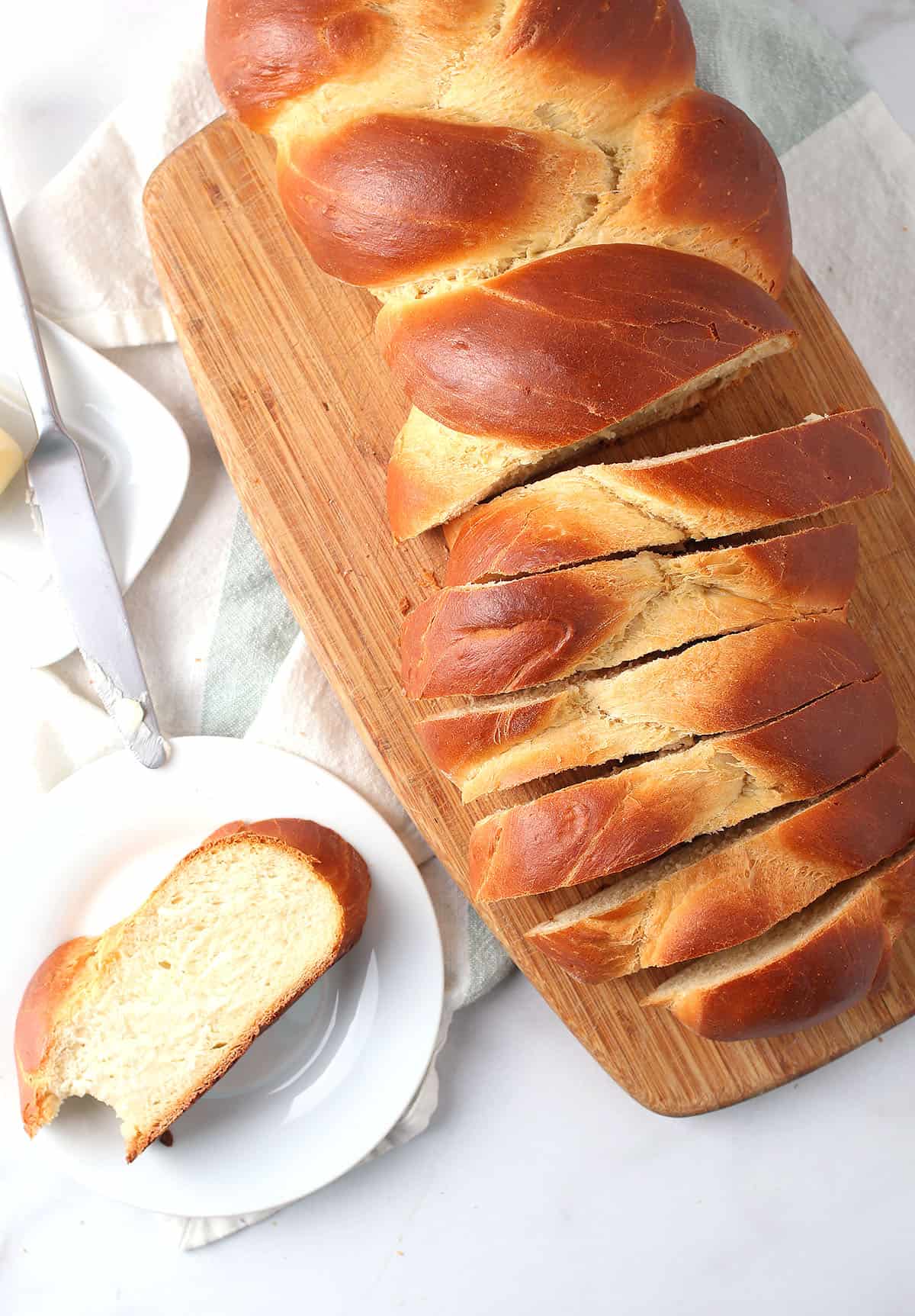
Disclosure: This post may contain affiliate links.
Years ago, I was a bread baker at a trending cafe and restaurant in Michigan. Sadly, the restaurant is now closed, but in the years that I baked bread for that wonderful place, I learned valuable lessons that I will take with me for the rest of my life.
One of the most popular breads we baked was our homemade challah. We used it for everything! It was the base of our french toast, the bread of many of our sandwiches, and pastry of choice for bread pudding.
Later, I moved onto other bakeries and continued making and perfecting challah. However, it wasn't until I quit working for other people and started working for myself that I started experimenting with vegan challah.
This recipe was one of the first recipes I created for this website, way back in 2012. Since then it has been made many times by my readers (that's, you!).
The recipe has been well loved and for that reason, I decided it was time to give it a little makeover.
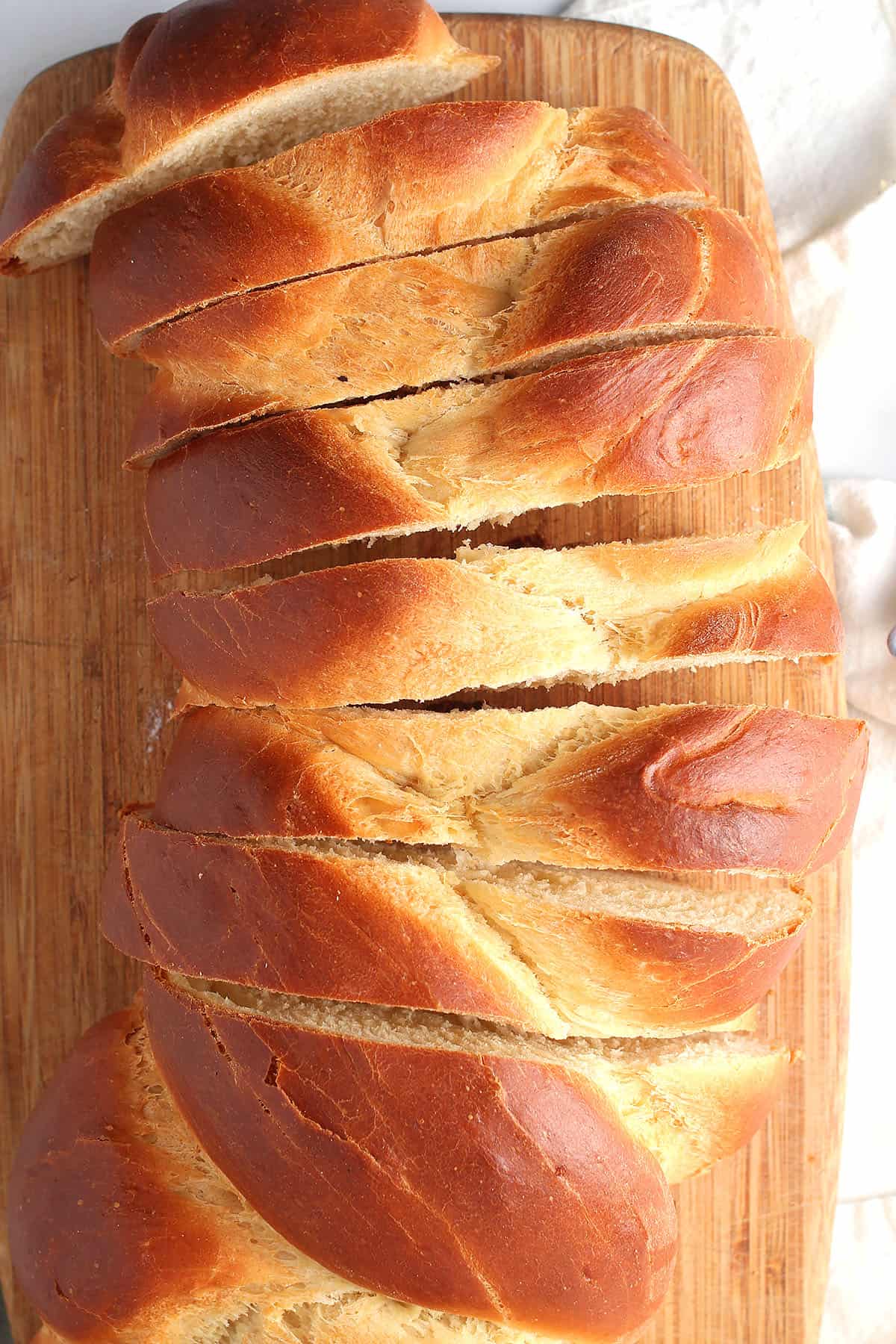
Ingredients & Substitutions
Challah is a soft, slightly sweet, enriched bread. The bread relies heavily on eggs and fat to give it that decadent texture. It took me several years to perfect this recipe and, friends, I think you're going to love it!
Here is everything you need.
- Active Dry Yeast - You can also use instant yeast if that's what you have on hand. The two are interchangeable in function. The only difference is that active dry yeast needs to be dissolved in a liquid to activate whereas instant yeast can be mixed right into the dough.
- Granulated Sugar - Check out my guide to vegan sugars.
- Chickpea Flour - This is used as the egg replacement. I love the chickpea flour eggs because they have a serious binding and leavening powder, similar to that of eggs which gives the bread its structure and lightness. Chickpea eggs are also completely flavorless meaning it won’t affect the taste of the bread itself. This is the only egg replacer that I recommend.
- Olive Oil - Most often I use olive oil but this recipe is also great with melted vegan butter.
- Salt
- All-Purpose Flour - I've had several people ask me if they can make this recipe gluten-free. I haven't yet tried using gluten-free flour, so I can't recommend it. If you've tried this recipe with a gluten-free flour blend, let us know how it turned out for you in the comment section below.
Step-by-Step Instructions
Step One - Make the Dough
Enriched yeasted dough often sounds far more intimidating than it is. While it takes time, the process is quite simple.
To start, place the yeast, 2 teaspoons of sugar, and warm water in the bottom of your bowl. Set aside for 10 minutes to allow the yeast to activate.
Pro Tip: It is very important that your water is warm but isn’t above 120F. Too hot and it will kill the yeast, making it unable to activate.
Slowly add the oil and chickpea egg, whisking while adding. Add the remaining sugar and salt. While mixing, gradually add the flour until dough begins to come together, but is still soft. This will be between 3-4 cups of flour depending on your altitude. The dough should be soft but not sticky.
Mix your dough for about 5 minutes in the stand-up mixer until it is well kneaded. Flip it out onto a floured surface and roll it into a ball. Place the dough in an oiled bowl, cover, and place in a warm area to let rise.
Step Two - Shape the Dough
After about 60 minutes, the dough should have doubled in size. Punch the dough down to release the air. Cover it and let it rise for an additional 30 minutes.
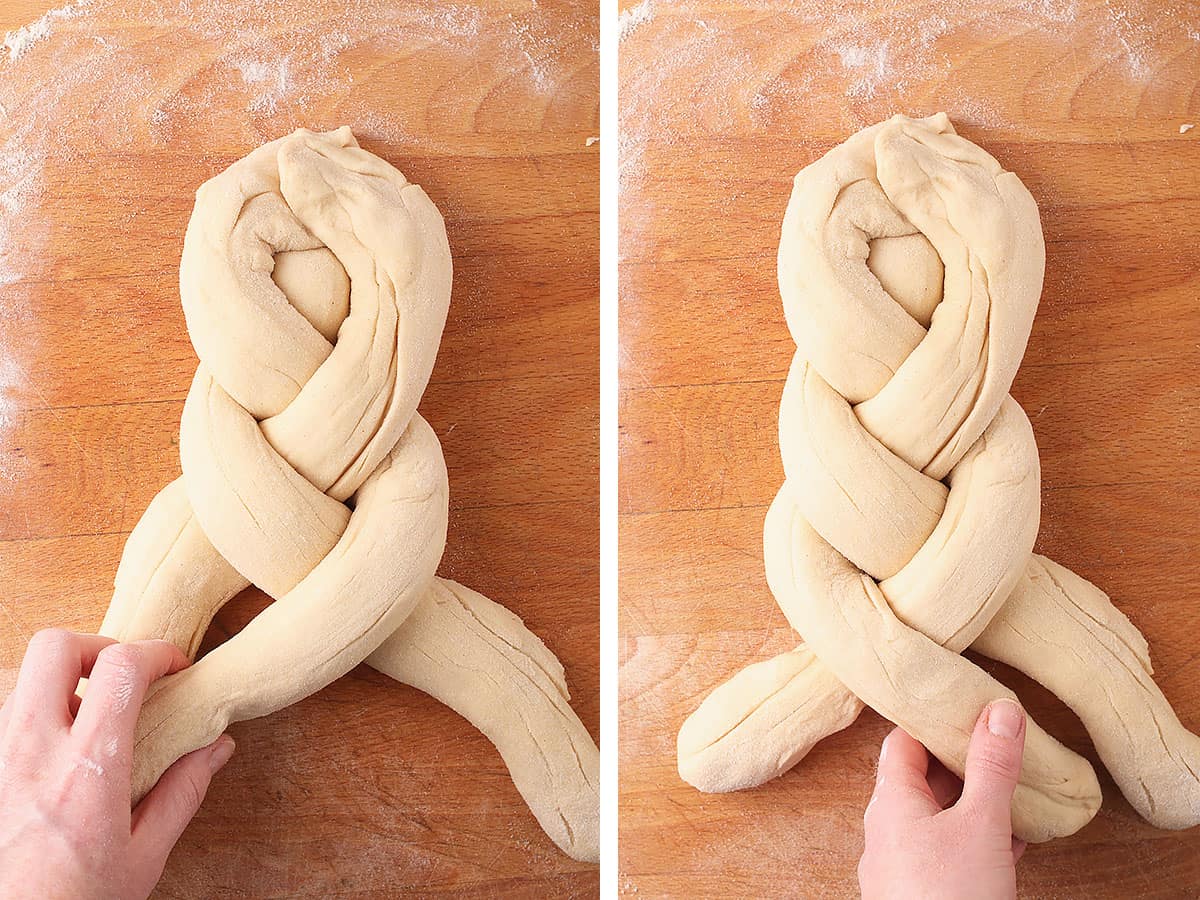
Flip the dough on a floured surface and cut into three equal pieces. A baking scale is the best way to ensure the pieces are even. Roll each piece into long strands (about 18 inches) and let sit for 5 minutes.
Once the dough has rested, braid it together, tucking in the ends underneath the loaf. Here is a good video tutorial.
Cover and let rest the dough rest for an additional 30 minutes.
Step Three - Bake the Bread
Preheat the oven to 375 degrees F. Brush loaf with soy milk one final time and bake 30-35 minutes, until the top is golden brown and a firm crust has formed.
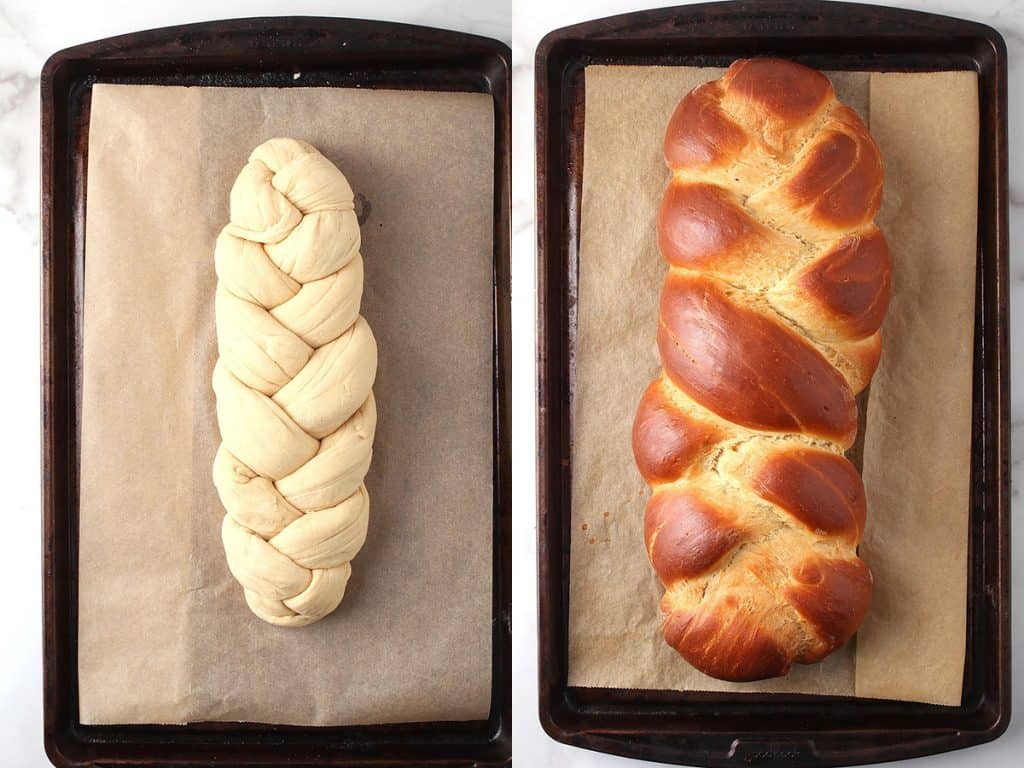
Remove from the oven and let it cool 10 minutes on a baking sheet before transferring it to a wire cooling rack to cool completely.
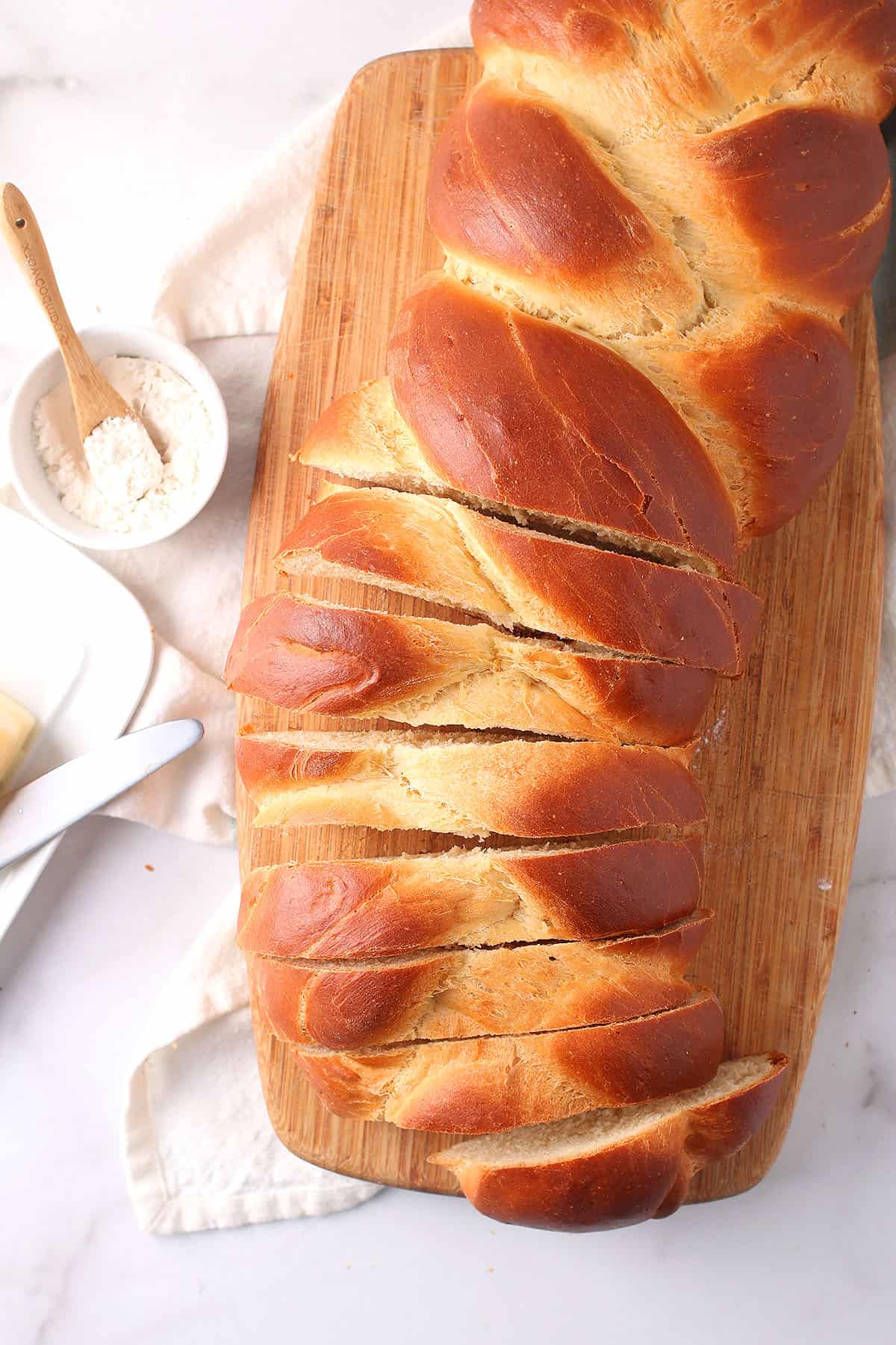
Serving and Storing
Serving - Serve this bread as a snack or part of a complete meal. Homemade Challah is perfect for French Toast or for sandwiches such as these Portobello Sandwiches with Caramelized Onions.
Storing - Store this bread in a plastic bag at room temperature for up to 5 days or in the freezer for up to 2 months.
Tips and Tricks
- Activate your yeast properly. To do this, make sure your yeast is not expired and the water is warm but not too hot. Otherwise, the yeast will not activate and you will not get a pillowy rise on the bread.
- Add flour slowly. The dough should be soft but not so sticky that you can’t handle it. This recipe calls for 3-4 cups of flour. Add it ½ cup at a time until you’ve achieved the desired dough.
- Let the dough rise in a warm place for 1 ½ – 2 hours, until the dough has doubled in size.
- Don’t skip the 2nd rise. Let your dough rise for an additional 30 minutes for a soft, melt-in-your-mouth texture.
Frequently Asked Questions
Unfortunately no. Chickpea flour is uniquely high in protein giving it binding and leavening powers that all-purpose flour simply cannot. You can find chickpea flour in most well-stocked grocery stores in the gluten-free aisle or you can pick some up online.
Yes, it can! If you want to make this sweet bread the night before, prepare the bread following the instructions below to the point of the 2nd rise. Once the bread is shaped, cover it with plastic wrap and place it in the refrigerator overnight. The next morning, remove the dough from the refrigerator 30 minutes prior to baking.
No! While a stand-up mixer makes this recipe much easier, you can certainly make this bread by hand. Simply combine the ingredients in a large mixing bowl and knead it together on a floured surface. Knead the dough for 10 minutes before the first rise.
I actually haven't tried this and so I can't recommend this but I am asked this question fairly frequently. If you've tried this recipe with a gluten-free flour blend, let us know how it turned out for you in the comment section below.
More Vegan Bread Recipes
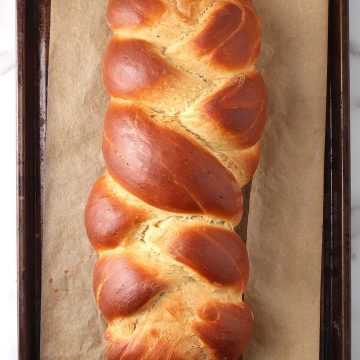
Vegan Challah
Ingredients
- 2 ½ teaspoon active dry yeast
- ¼ cup + 2 tsp sugar
- 1 cup water
- ½ cup chickpea flour + ½ cup water
- ¼ cup olive oil
- 1 ½ teaspoon salt
- 3-4 cups all-purpose flour
Instructions
- In a stand-up mixer, with the dough hook attachment, whisk together yeast, 2 teaspoons sugar, and 1 cup lukewarm. Set aside for 5 minutes to allow the yeast to activate and sugar to dissolve.
- In a food processor or blender, blend together the chickpea flour along with ½ cup water until it is thick and foamy. This is your chickpea egg. Set aside.
- With the motor running, slowly add the oil and chickpea egg into the yeast mixture. Add the remaining ¼ cup of sugar and salt. Whisk together. Gradually add the flour, one cup at a time, until the dough begins to come together. Turn the speed to medium-high and knead for 5 minutes until dough begins clearing the sides and forms a smooth ball. You want the dough to feel soft, but not sticky.
- Remove the dough and place it in an oiled bowl. Cover and let rise in a warm place for one hour, until doubled in size. Punch the dough down to remove any air bubbles, re-cover, and let rise an additional 30 minutes.
- Turn the dough on a floured surface and cut into three equal pieces. Roll each piece into long strands (about 18 inches) and let sit for 5 minutes. Now, braid the challah. Here is a good video tutorial.
- Brush the loaf with soy milk and set aside to rise for 30 more minutes, until dough slowly pushes back when an indentation is created with your finger.
- Preheat the oven to 375 degrees F. Brush loaf with soy milk on final time and bake 30-35 minutes, until the top is golden brown and a firm crust has formed.
- Let cool completely before slicing.
Notes
- Activate your yeast properly. To do this, make sure your yeast is not expired and the water is warm but not too hot. Otherwise, the yeast will not activate and you will not get a pillowy rise on the bread.
- Add flour slowly. The dough should be soft but not so sticky that you can’t handle it. This recipe calls for 3-4 cups of flour. Add it ½ cup at a time until you’ve achieved the desired dough.
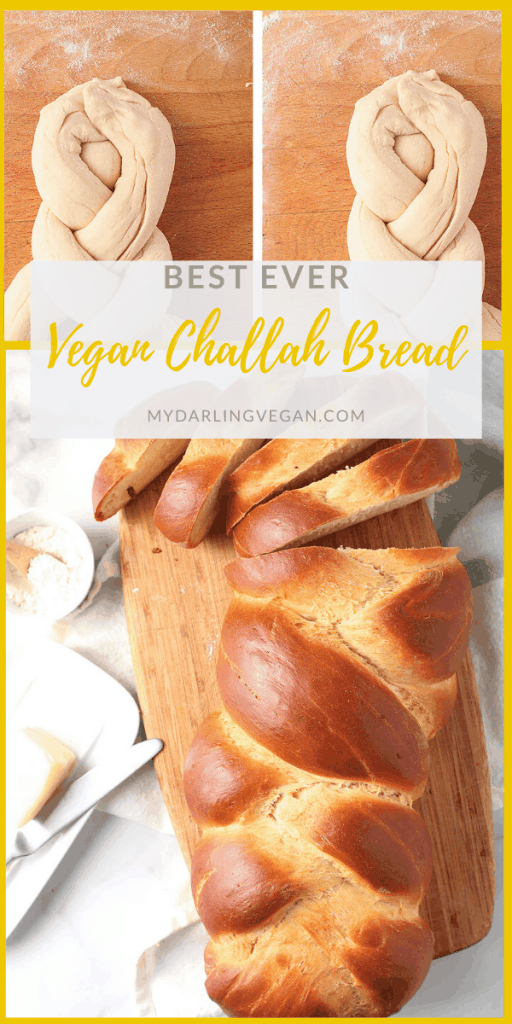
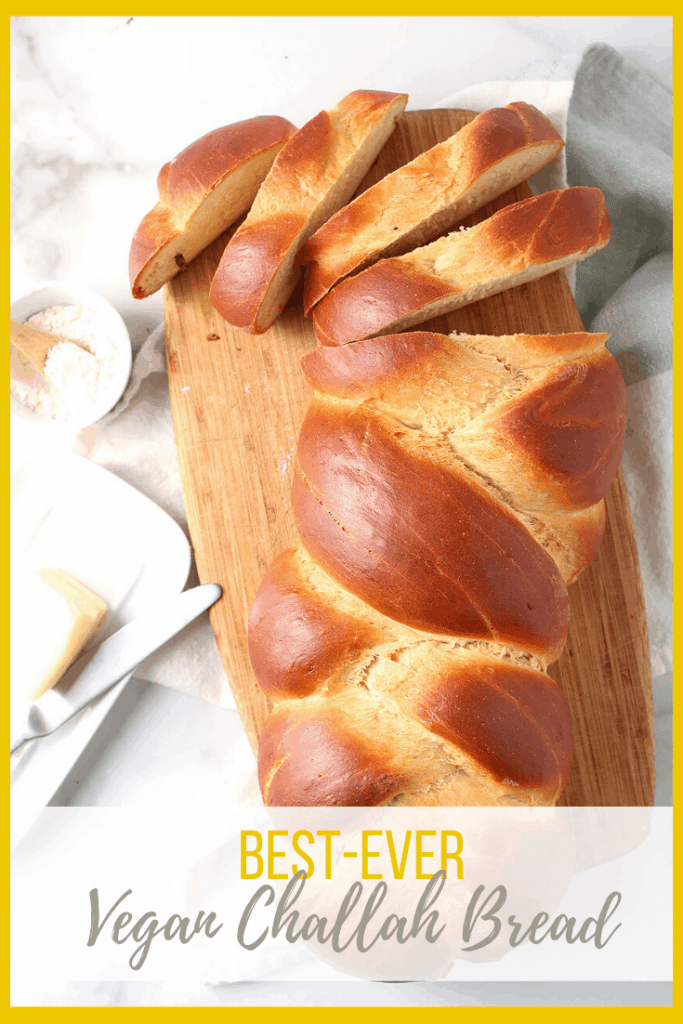
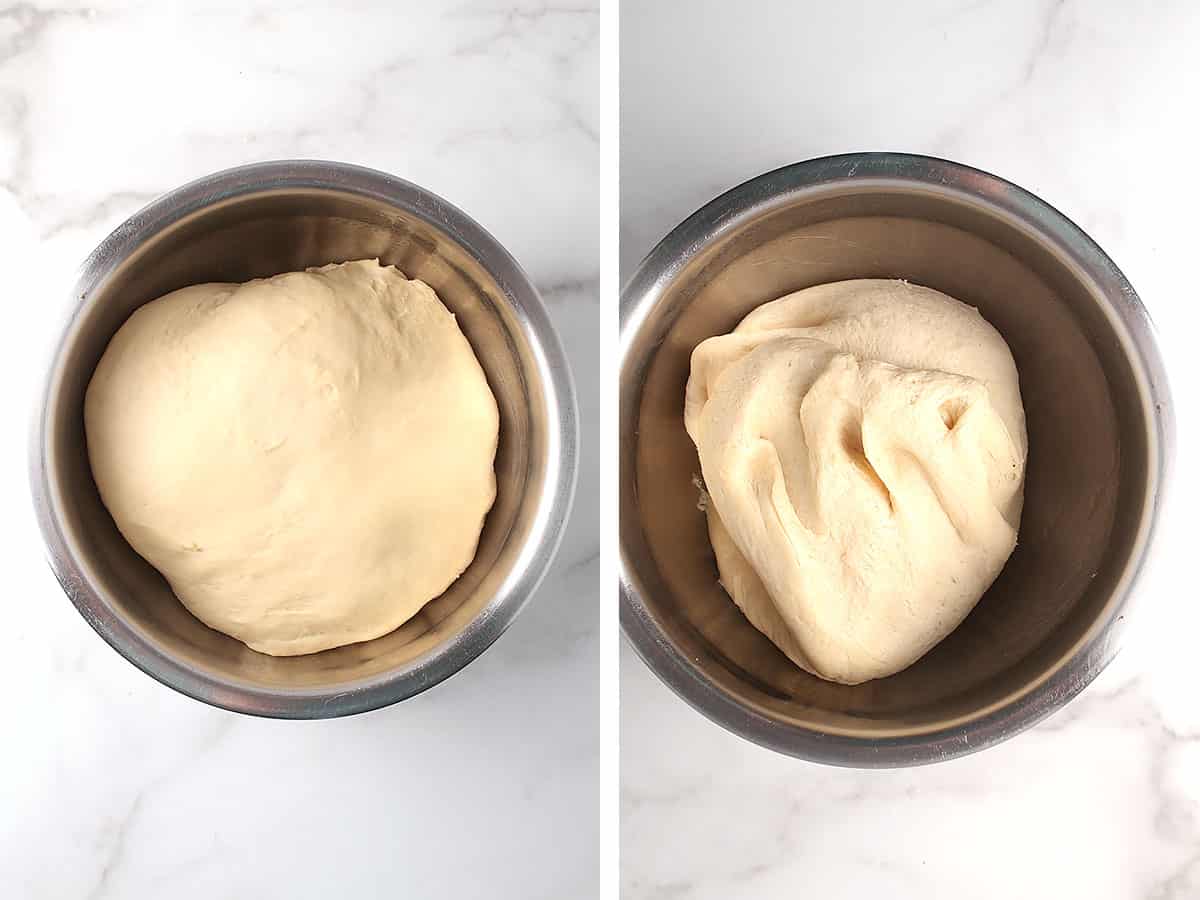
 Hi, I’m Sarah. I’m a 14-year (and counting) vegan, professionally trained photographer, former pastry chef, founder of My Darling Vegan, and author of the
Hi, I’m Sarah. I’m a 14-year (and counting) vegan, professionally trained photographer, former pastry chef, founder of My Darling Vegan, and author of the
Rach says
This was fantastic- I can see why it is so popular. Perfect first time and hit with the whole family. My oldest thinks the shape looks like the ski moguls 🤣
Lisa says
I adapted this recipe to make an egg-free, gluten-free tsoureki, Greek Easter bread. The chickpea "egg" worked beautifully. I added oat flour for structure--only about a cup mixed with 2.5 C. all purpose GF flour mix. The flavorings for tsoureki, in case anyone is interested was an additional 2 grams of ground mastic and about 8g of ground mahleb with the zest of one medium orange. It was definitely better the first day, but excellent for toasting on day two! It's difficult to create good GF bread in any case, but especially without eggs. Thanks for a great base recipe!
Deborah says
Wonderful! So enjoyable to make, and even more enjoyable to eat!
Stacy Rosenfeld says
Can any flavoring be added with candied peel, juice or raisins?
Nicole says
I've never made Challah before and your recipe made it so simple! I did have to add more than the 4 cups of flour to get it not sticky.
It turned out fantastic. The family raved about it and I'll definitely be making this regularly. It looks very fancy and if the day ever comes when we can do pot lucks again, this would be a stunner! Thank you!
Vanessa says
Great recipe! The only substation I made was using some canola oil as I ran out of olive oil. It turned out well although my dough was pretty sticky despite adding almost the four cups of flour. Not sure if I should have added more or kneaded longer . My braid also lost shape. I’m hoping to do better on that next time.
Ann Langlands says
Hi - do you think I could use cassava flour instead of white flour ? Or an alternative gluten free flour?
Thanks,
Ann
Sarah McMinn says
I've had readers have luck with a 1:1 gluten free flour blend. You can look through the comments and see what was said about it.
Isabelle Benard says
This is my go to recipe and it never fails to amaze me. My family loves it so much. Thank you so much for your recipe!!
Elissa says
This recipe is beyond 5 star. I grew up eating the greatest challah in New York. All made with eggs, & lots of oil. Since going plant based I have tried other vegan recipes--some made with banana. They were just OK. Challah should never, evah, be OK. We were astounded at the texture & flavor. I was curious at using chick-pea flour for the egg, & it definitely foamed up in the processor as described. The recipe is to die for. Looking forward to French Toast!
Ceri says
Made this for the first time today and we’ve struggled not to eat the whole thing in one go. Really easy to follow recipe. Thank you!
Diana Foggia says
Sarah,
I want to make this, but, I have instant yeast and wanted to know if I follow your recipe as if I'm using active?
Sarah McMinn says
Yes, that would work.
Alice says
This was really delicious!!! I've never tried traditional challah so I don't know how it compares, but it was so nice
Sally says
Is it possible to create 12. rolls instead of the entire challah.? If so how would I bake them & at what temperature?
Sarah McMinn says
For sure. I would bake them at the same temperature. Start with 25 minutes and check on them for doneness by tapping on them lightly. They should sound slightly hallow on the inside.
Rachel says
I made this yesterday and it came out so well! Next time I’ll try it with some add ins. Yum
Cheryl says
Have you used instant yeast instead of the active? I’ve run out of active yeast and it’s hard to come by these days!
Sarah McMinn says
You should be able to use instant yeast. It just won't take as long to rise.
nixter says
can i make this completely gluten free so use g free flour if so do i need to add some bicarb or baking powder
Sarah McMinn says
I haven't tried this recipe with gluten-free flour but if you give it a try, let us know how it turns out!
Nicole says
Has anyone tried making this gluten free? My son is recently gluten, dairy, egg and soy free. Baking for him is a total nightmare. I’d love to make this bread gluten free but have had so many baking failures this week and just can’t take another fail. Plus I’m running out of flour! I need someone’s clear advice before attempting this.